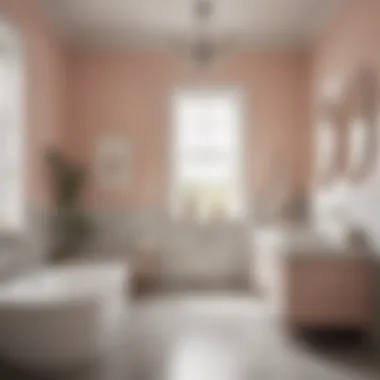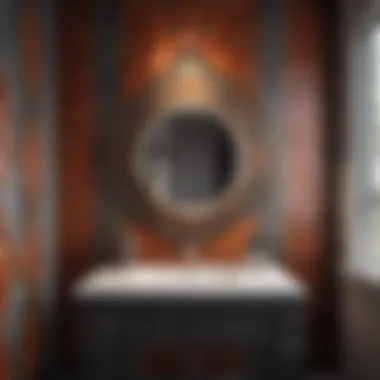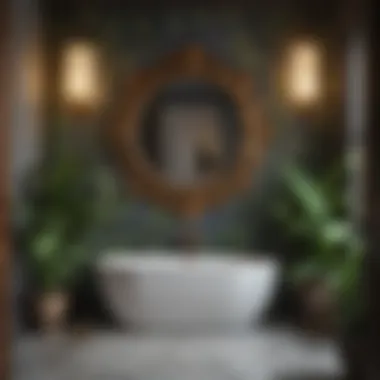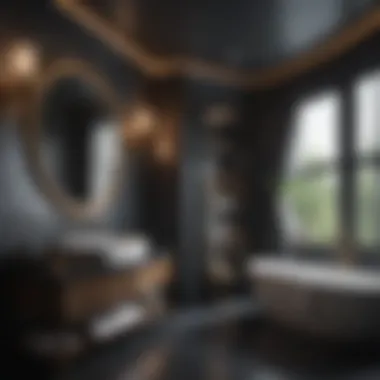Innovative Bathroom Painting Design Ideas


Intro
Embarking on a bathroom painting project can be both exciting and daunting. The bathroom, often overlooked in terms of aesthetics, can be transformed into a personal sanctuary with the right design ideas. This article aims to provide you with a well-rounded understanding of bathroom painting design options, focusing on innovative color choices and effective application techniques that breathe new life into what might be an ordinary space.
By exploring the psychology of color, the significance of selecting moisture-resistant paints, and offering practical tips for execution, this guide is tailored for homeowners and design enthusiasts alike. As you read through, you will discover how thoughtful design can elevate your bathroom from functional to fabulous.
Design Inspirations
Trending Styles
The current trends in bathroom design reflect a blend of modern minimalism and classic elegance. Popular styles often include:
- Scandinavian: Utilizes light colors, focusing on simplicity and functionality.
- Industrial: Incorporates raw materials like metal and wood, enhancing both aesthetics and durability.
- Vintage: Features retro wallpapers and pastel shades that evoke nostalgia.
Each style presents an opportunity for creative expression. For example, a Scandinavian-inspired bathroom can benefit from soft pastel colors accentuated by white trim. An industrial theme may leverage darker hues to create a striking contrast with metallic fixtures.
Color Palettes
Color plays a critical role in establishing the mood within your bathroom. Here are some popular palettes:
- Calming Neutrals: Soft whites, grays, and beiges promote tranquility.
- Bold Accents: Deep blues or greens can add drama when paired with lighter tones.
- Earthy Tones: Shades of browns and olive can create a natural ambiance.
When choosing colors, consider the bathroom's size and natural light. Lighter colors can make a small bathroom feel bigger, while deeper shades add warmth and intimacy. Also, contrast is crucial; a balance between lighter and darker colors can create depth and interest in the design.
Product Recommendations
Moisture-Resistant Paints
Choosing the right type of paint is essential for bathroom longevity. Some recommended moisture-resistant options include:
- Benjamin Moore Aura: Known for its mildew resistance and easy cleanability.
- Behr Premium Plus: Offers a premium finish and durability against moisture damage.
- Sherwin-Williams Duration: Combines excellent coverage with moisture resistance as well.
These paints not only withstand the challenges of a humid environment but also enhance the overall aesthetic due to their quality finish.
Practical Tips for Execution
To achieve a professional-looking paint job, consider the following:
- Prep the Surface: Clean walls thoroughly to remove any residues. Fill holes or imperfections for a smooth finish.
- Use Primer: A quality primer will ensure better adherence and coverage of your chosen paint.
- Select the Right Tools: High-quality brushes and rollers will produce superior results.
"Investing time in preparation is crucial for any painting project. It significantly affects the final outcome."
Remember to keep the practical aspects, such as moisture resistance, in mind while you select your colors and designs.
Understanding Bathroom Aesthetics
The aesthetics of a bathroom is crucial as it affects not only the visual appeal but also the overall comfort and functionality of the space. In today's homes, bathrooms are more than just utility areas; they serve as personal retreats. Thus, understanding how design elements interact can drastically reshape a bathroom's atmosphere.
One of the core components in bathroom aesthetics is the color scheme. Colors can evoke emotions, alter perceptions of space, and influence mood. For example, cool colors such as blues and greens often create a calming effect, ideal for relaxation. Conversely, warmer colors like reds and oranges might add energy but can be overpowering in small spaces. Careful consideration of color can help transform the bathroom into a soothing environment. Choosing colors that harmonize with existing fixtures can enhance continuity.
The layout and arrangement of elements also play an important role. For instance, the placing of mirrors can amplify light and give the illusion of a more spacious area. Light fixtures should complement the paint choice, ensuring enough illumination while avoiding harsh shadows. Attention to details like these contribute significantly to the aesthetic appeal of the bathroom.
Moreover, current trends in bathroom design reflect an increasing preference for personalized spaces. Homeowners are more inclined to express individuality through unique color choices and design techniques. This allows for a blend of functionality with artistic touch, marrying practicality with style.
"A well-designed bathroom combines comfort with functionality, creating a personal sanctuary beyond mere utility."


Ultimately, understanding bathroom aesthetics is about more than just visual appeal. It encompasses all elements that contribute to the bathroom's function and emotional resonance. Aesthetic considerations can elevate a bathroom, making it feel more inviting and aligned with personal style.
Choosing the Right Paint Finish
Choosing the right paint finish is essential for achieving a polished look and longevity in any bathroom environment. The paint finish impacts not only the aesthetic quality of the space but also its durability, particularly in a moisture-rich atmosphere like a bathroom. When selecting a finish, consider factors such as ease of cleaning, light reflection, and how well it can withstand humidity. Incorrect selection can lead to rapid wear and deterioration of the paint, making it necessary to repaint sooner than intended.
Exploring Different Paint Finishes
Paint finishes can generally be categorized into several types, including flat, eggshell, satin, semi-gloss, and gloss. Each finish has its unique characteristics:
- Flat Finish: Absorbs light and is often used for ceilings or low-traffic areas. Not suitable for bathrooms due to moisture.
- Eggshell Finish: Slightly more sheen than flat; works well in low-humidity areas but still may not withstand heavy moisture.
- Satin Finish: Balances sheen and durability, making it a popular choice for bathrooms.
- Semi-Gloss Finish: Highly reflective, easy to clean, and resistant to moisture. Great for surfaces prone to splashes.
- Gloss Finish: Offers the highest sheen and best moisture resistance but can show imperfections more distinctly.
Determining which finish to use comes down to the specific needs of your bathroom and personal preferences.
Benefits of Satin vs. Semi-Gloss Paint
Satin and semi-gloss paints each offer distinct advantages.
- Satin Paint: Provides a softer, more muted finish while still offering some washability. Its lower sheen can help hide imperfections on walls and provide a relaxing vibe, which is desired in a bathroom setting. This finish is ideal for walls that experience less direct moisture exposure.
- Semi-Gloss Paint: This finish provides a more reflective surface and is much easier to clean, making it better suited for bathroom environments where water can splash on the walls. It resists mildew and mold better than satin, offering more durability over time.
Consider your bathroom's specific needs.
Selecting between satin and semi-gloss could depend on traffic levels, humidity styles, and the overall look you wish to achieve.
Considerations for Moisture Resistance
Bathrooms are unique due to their high moisture levels, making moisture resistance a key factor when choosing paint finishes. Each finish's ability to repel moisture is crucial for maintaining a clean and attractive space. Here are a few factors to consider:
- Mold and Mildew Resistance: Look for paints specifically formulated to inhibit mold and mildew growth. These paints often contain antimicrobial additives that provide additional protection in damp environments.
- Type of Paint: Water-based paints generally perform better in humid conditions compared to oil-based paints, which may trap moisture and lead to peeling.
- Ventilation: Ensure adequate ventilation in your bathroom. A well-ventilated bathroom reduces humidity levels and helps prolong the life of the paint.
When selecting your paint finish, always prioritize moisture resistance. The right choice can prevent costly repairs and maintain your bathroom's beauty for years to come.
Popular Color Schemes for Bathrooms
Neutral Tones and Their Appeal
Neutral tones are timeless. They provide a clean, cohesive look that appeals to a broad range of tastes. Colors like soft whites, grays, and beiges can create a serene environment. They work well with various materials, such as tiles and wood, making coordination easier. Using neutral colors can also enhance the sense of space, which is valuable in smaller bathrooms.
The neutrality allows for greater flexibility when selecting accessories and accents. You can easily switch towels, rugs, and decor without clashing colors. Additionally, neutral tones can bring warmth or coolness based on the light quality in the room. This versatility makes them a popular choice amongst homeowners who want a lasting style that does not quickly go out of trend.
Bold Colors for a Statement Space
Bold colors can inject personality into a bathroom. Rich blues, deep greens, or vibrant reds can turn a mundane area into a visually stimulating space. These colors often serve as focal points, drawing attention to specific features like a luxurious bathtub or unique tile design.
When using bold shades, it is important to balance intensity. Pairing a bold color on one wall with lighter shades on the others can maintain harmony. It is also wise to use bold colors in spaces that are rather large to prevent feelings of claustrophobia. Homeowners may consider using these hues in powder rooms or guest bath areas for a striking impression.
Pastel Palettes for a Soothing Ambiance
Pastel colors have grown in popularity for those seeking a soothing atmosphere. Light pinks, blues, and purples can evoke tranquility, making them suitable for personal retreats. Pastel shades can soften the harsh lines of bathroom fixtures, creating a gentle look.
These colors work particularly well with natural light, reflecting brightness and contributing to an airy feel. A pastel palette is also effective in creating a cohesive look with other bathroom elements like shower curtains and bath mats. This choice is ideal for bathrooms used for relaxation, as they help to create a calming environment.
In summary, a well-thought-out color scheme can dramatically enhance the aesthetic and functional quality of a bathroom. Selecting between neutral, bold, or pastel palettes requires careful consideration of personal style, existing finishes, and how the colors will interact over time.
Patterns and Techniques in Bathroom Painting


Choosing the right patterns and techniques for painting a bathroom can significantly shape both its aesthetic and functional qualities. Patterns can add character and depth to a simple space, while techniques enhance the application of paint and the overall finish. Using patterns and diverse methods allows for personalization, transforming a standard bathroom into a unique retreat. Homeowners often encounter a vast array of options that can seem overwhelming. Understanding the impact of these choices is essential.
Creating Accent Walls with Paint
Accent walls are a popular choice in bathroom design and can serve as a focal point for the space. The role of an accent wall is to draw attention and provide contrast to the other walls. When selecting a wall to paint as an accent, consider factors like visibility and light. Generally, the wall behind a vanity or tub works well.
When applying paint for an accent wall, it is important to choose a color that complements the existing palette. Bold colors can create drama and visual interest. For example, a vibrant navy wall can enhance a light gray bathroom. Techniques like sponging may also be employed to create texture on the surface, adding further depth. To achieve the best results, proper preparation of the wall is crucial, including cleaning and priming before any paint application.
Geometric Patterns and Their Impact
Geometric patterns can invigorate a bathroom with modern sophistication. These designs can vary from simple lines to intricate shapes, offering versatility based on personal style. When choosing a geometric pattern, consider the size of the bathroom. Small spaces may benefit from smaller patterns, while larger areas can accommodate bigger designs.
To apply a geometric pattern effectively, it often involves using painter's tape to ensure crisp, clean lines. Painters should start with a base color, allowing it to dry fully before layering on other colors for the geometric shapes. This technique results in a striking and polished look.
Furthermore, geometric patterns can also contribute to a sense of movement within the space. They can guide the eye around the room, creating an illusion of more space, which is particularly valuable for smaller bathrooms.
Stripes: Simple Yet Effective
Stripes are a classic technique that remains relevant in bathroom design. This method provides a clean, structured look and can visually heighten or widen a space, depending on the orientation of the stripes. Vertical stripes can make a ceiling feel higher, while horizontal stripes can create the appearance of a wider room.
For an effective striped look, consider the color combinations. Using two contrasting colors or shades of the same hue can create a stylish and modern feel. As with geometric patterns, painter's tape is indispensable for creating sharp lines. The process requires precision and attention to detail, but the results can truly elevate the bathroom's atmosphere.
Stripes are especially beneficial for those seeking an easy-to-apply and cost-effective method to refresh their bathroom without a complete overhaul.
"Patterns in painting are not just for aesthetics; they can expand the perception of space and make a bold statement in design."
Eco-Friendly Paint Options
In the modern age, environmental consciousness has become pivotal in various aspects of home improvement, including painting. Eco-friendly paint options not only contribute to a healthier living space but also minimize the ecological footprint. This section explores the significance of eco-friendly options in bathroom painting, describing the benefits and considerations involved in selecting these paints.
The Importance of Low-VOC Paints
Low-VOC (Volatile Organic Compounds) paints are essential for homeowners who wish to maintain indoor air quality while using paint products. These compounds, often released into the air as paints dry, can lead to air pollution and health problems, including respiratory issues.
Opting for low-VOC paints provides several advantages:
- Healthier Indoor Environment: Reducing the number of harmful chemical emissions promotes a safer atmosphere in kitchens and bathrooms, where ventilation is often limited.
- Reduced Odor: Low-VOC paints generally have fewer noxious odors, making the painting process more tolerable.
- Environmental Responsibility: By choosing low-VOC options, you actively participate in protecting the environment, as they are typically made with sustainable materials.
In summary, using low-VOC paints benefits both health and environmental sustainability, making them a crucial consideration for any bathroom painting project.
Sustainable Brands to Consider
When searching for eco-friendly and low-VOC paint, it is important to consider brands that prioritize sustainability. Here are some notable companies that offer such products:
- Benjamin Moore: Their Regal Select line includes low-VOC options without compromising on quality or durability.
- Behr: Known for their Premium Plus range, Behr offers zero-VOC and low-VOC paints suitable for bathrooms.
- Sherwin-Williams: They feature the Harmony line, which is both low-VOC and antimicrobial, making it ideal for moisture-prone areas.
- EarthSafe: As the name suggests, this brand focuses on creating eco-friendly paints, with a wide selection of colors and finishes to meet various design requirements.
It is wise to look for certifications like Green Seal or EcoLogo when choosing paint brands. These labels confirm that the products meet strict environmental and performance standards.
Opting for sustainable brands not only enhances your home’s aesthetics but also fosters a healthier planet.
DIY Painting Tips for Homeowners
Undertaking a painting project in your bathroom can seem daunting, yet it offers a powerful opportunity to personalize your space. DIY painting can be both economical and fulfilling. It empowers homeowners to choose colors and techniques that reflect their style. Moreover, it allows for greater flexibility compared to hiring a professional. This section provides essential tips to navigate the process with confidence and skill.
Preparing Your Bathroom for Painting


Before you even open a can of paint, preparation is crucial. Start by removing all items from the bathroom. This includes toiletries, towels, and decorations. Cover your fixtures with drop cloths or plastic sheets. Also, take off any hardware like towel racks or outlet covers. This not only protects your belongings but also makes the painting process easier.
Next, inspect the walls for imperfections. Fill any holes or cracks with spackling paste. Sand the areas smooth to ensure a flat surface. Cleaning the walls thoroughly is also important. Use a mixture of water and vinegar to eliminate soap scum and mildew. A clean surface allows the paint to adhere better, which results in a more professional-looking finish.
Essential Tools for a Successful Paint Job
Having the right tools can make your DIY project much smoother. Here is a list of essential tools you will need:
- Paint Brushes: A variety of sizes including angled brushes for corners and trim.
- Rollers: Consider a short nap roller for smooth surfaces, and a longer nap roller for textured walls.
- Painter's Tape: Use this to create crisp lines where walls meet trim or adjacent colors.
- Paint Tray: A must-have for loading your roller with paint.
- Drop Cloths: Protect your floors from spills and splatters.
- Sandpaper: For smoothing surfaces before you paint.
- Spackling Paste and Putty Knife: For repairs on walls.
- Safety Gear: Dust mask, goggles, and gloves for protection.
Gather these tools to streamline your painting process and help avoid setbacks.
Applying Paint: Techniques for a Flawless Finish
Once your bathroom is prepared and tools ready, you can start painting. First, it is wise to cut in your edges. This means using a brush to paint the edges of the walls where they meet the ceiling or adjoining walls. Use painter's tape to achieve clean edges and protect adjacent surfaces.
Next, use a roller to fill in the larger areas. Apply paint in a "W" pattern; this helps distribute the paint evenly. Ideally, the first coat should be thin. Allow it to dry completely before applying a second coat. Each coat should also be allowed to dry between applications, helping to achieve that desired depth of color and a more durable finish.
In spaces like bathrooms, moisture can be a concern. Make sure to use moisture-resistant paint for longevity.
"Proper preparation and attention to detail in applying paint ensure a stunning finish that can transform your bathroom into a personal sanctuary."
By following these steps, you can ensure that your DIY painting project is not only successful but also reflects your personal style. A well-painted bathroom enhances your home’s aesthetic and can elevate your everyday experience.
Hiring a Professional Painter
The decision to hire a professional painter for your bathroom can significantly affect the final outcome. Unlike other rooms, bathrooms require careful consideration of moisture control and paint application techniques. By understanding when to seek professional help and what to look for in a painter, homeowners can ensure a high-quality finish that enhances both the aesthetics and functionality of the space.
When to Consider Hiring Help
Not every homeowner is equipped for the demands of bathroom painting. If you prioritize a flawless result, hiring a professional may be the best option. Here are specific scenarios when you should consider this:
- Limited Experience: If you lack painting experience, you might not know the best techniques for applying paint or how to handle moisture-resistant products.
- Complex Designs: Custom or intricate designs may require a level of skill that only experienced painters possess. Professionals can execute complex patterns with precision.
- Time Constraints: Painting a bathroom can be time-consuming. If your schedule doesn’t allow for extensive DIY projects, hiring a pro can save you valuable time.
- Safety Risks: Older homes may have structural issues, or you might need to deal with high ceilings or awkward spaces. Professionals are trained to navigate these challenges safely.
Evaluating Painters: What to Look For
Choosing the right painter is crucial. Not all painting professionals provide the same level of service or expertise. When evaluating potential painters, consider these factors:
- Experience and Specialization: Look for painters who specialize in bathroom projects. Ask about their previous work and whether they have handled similar jobs.
- Licenses and Insurance: Ensure the painter has the necessary licenses and insurance. This protects you in case of accidents or damage during the project.
- References and Reviews: Check for reviews and ask for references. Feedback from previous clients can provide insights into their work quality and reliability.
- Detailed Estimates: A good painter will provide a clear and detailed estimate. This should outline the costs, materials, and time frame involved in the project.
- Consider Communication: Effective communication is essential. You want a painter who listens to your ideas and provides professional advice.
“Hiring the right painter can transform your bathroom beyond simple aesthetics, ensuring durability and quality in the long run.”
Finishing Touches After Painting
Completing a painting project for your bathroom is a significant accomplishment. However, the final phase—finishing touches—often determines the overall success of your design. This stage involves not only adding decorative elements but also ensuring that every detail enhances the functionality and aesthetics of the space. The carefully selected accessories and the introduction of textures can dramatically change the character of the room.
Choosing the Right Accessories
Accessories can serve as a focal point or subtle enhancement, depending on how they are chosen. Items like towels, soap dispensers, and wall art can either complement or clash with your painted surfaces. Here are some considerations:
- Color Coordination: Select accessories that harmonize with your paint choices. If your bathroom features bold colors, opt for neutral accessories to balance the visual weight.
- Material Selection: Choose materials that resist moisture. Metal, glass, and certain plastics are preferable, as they withstand humidity better than others like wood or fabric.
- Functionality vs. Aesthetics: While it’s important to choose aesthetically pleasing items, ensuring they are also functional is crucial. For example, look for stylish yet practical storage solutions for toiletries.
"Accessories are an opportunity to show personal style. Choose items that reflect your taste while serving a purpose."
By thoughtfully selecting your accessories, you can create a cohesive look that enhances your overall design.
Incorporating Textures and Patterns
Textures and patterns can add depth to an otherwise flat appearance. They enliven the space, making it feel more dynamic and inviting. Here are some techniques to consider:
- Textured Walls: Consider using a sponge technique or a rag rolling effect to add texture to your painted walls. This adds depth and character without overwhelming the senses.
- Layering Materials: Introduce various textures through towels, rugs, and shower curtains. A plush rug can contrast beautifully against smooth tiles or painted surfaces, creating a sense of luxury.
- Accent Pieces: Incorporate patterned elements such as wallpaper on one wall or decorative decals. These can serve as accents to your paint choice, drawing attention and creating a focal point.
Balancing textures and patterns requires a careful approach, but when done right, it results in a beautifully curated bathroom that feels both inviting and stylish.



